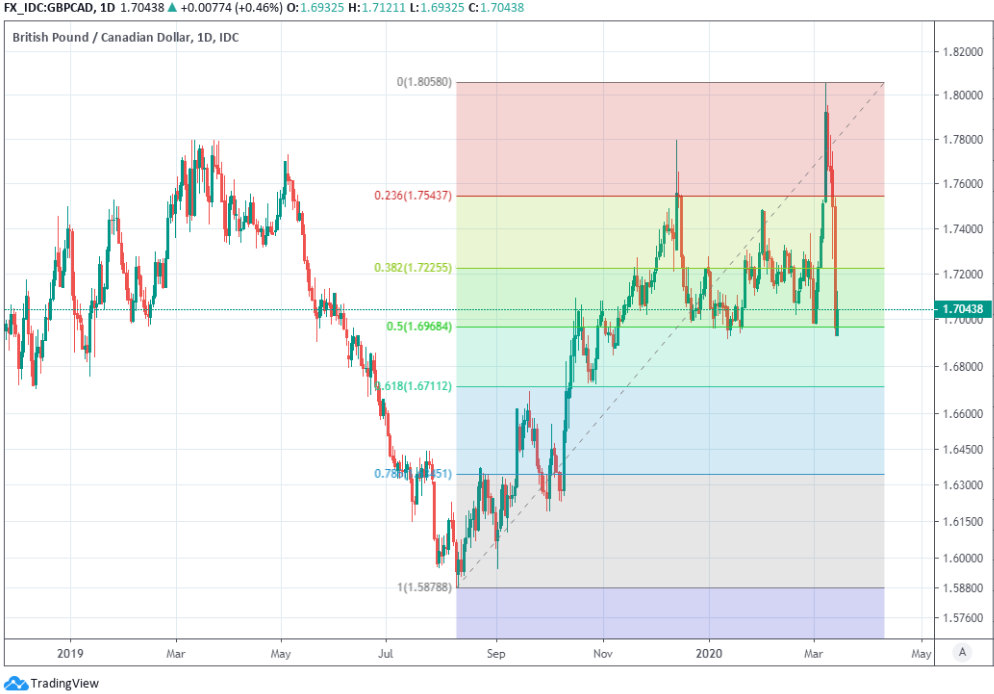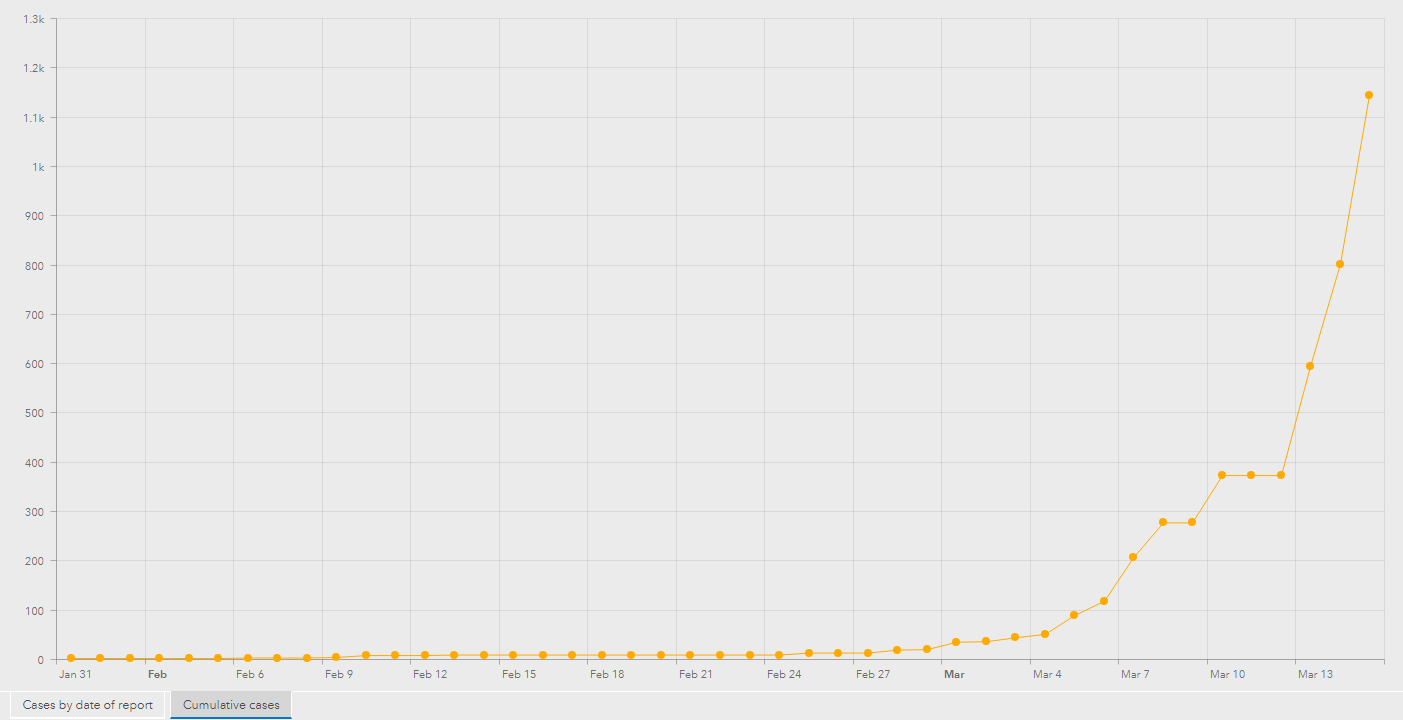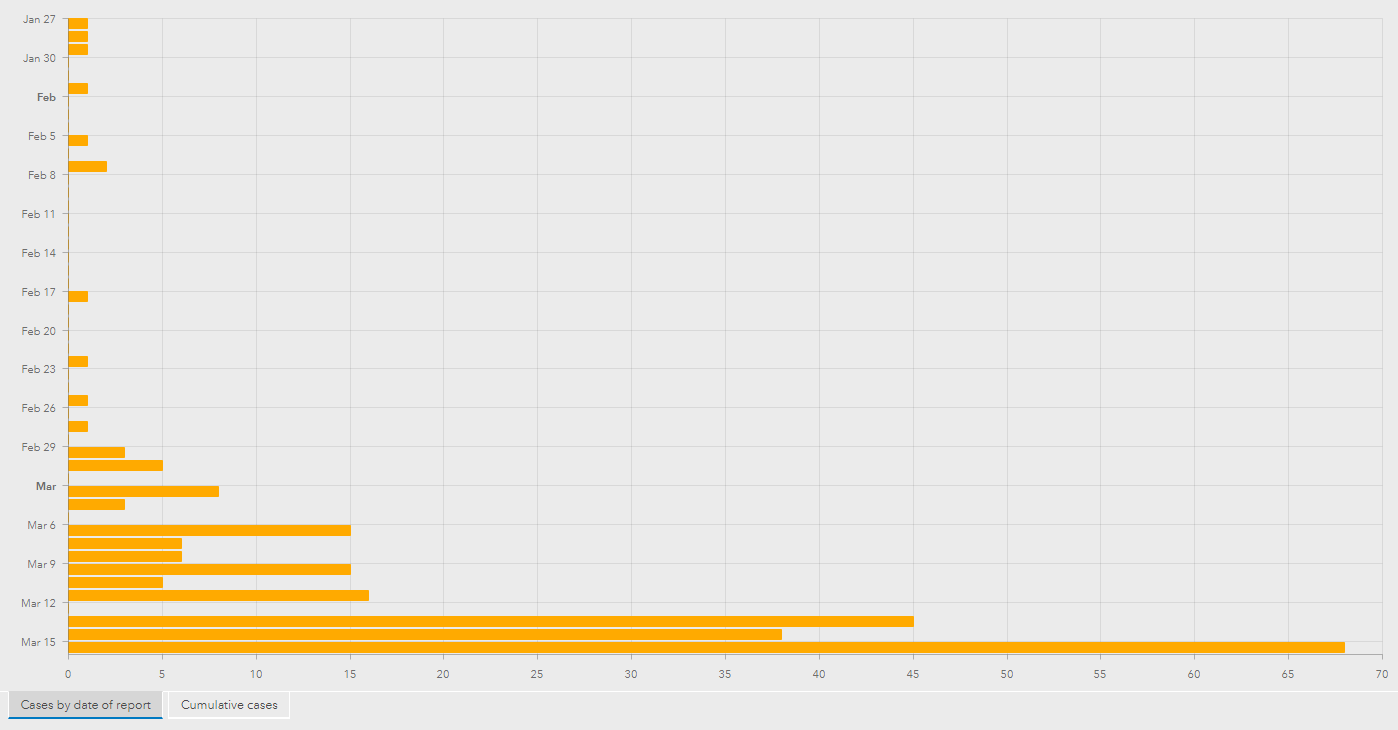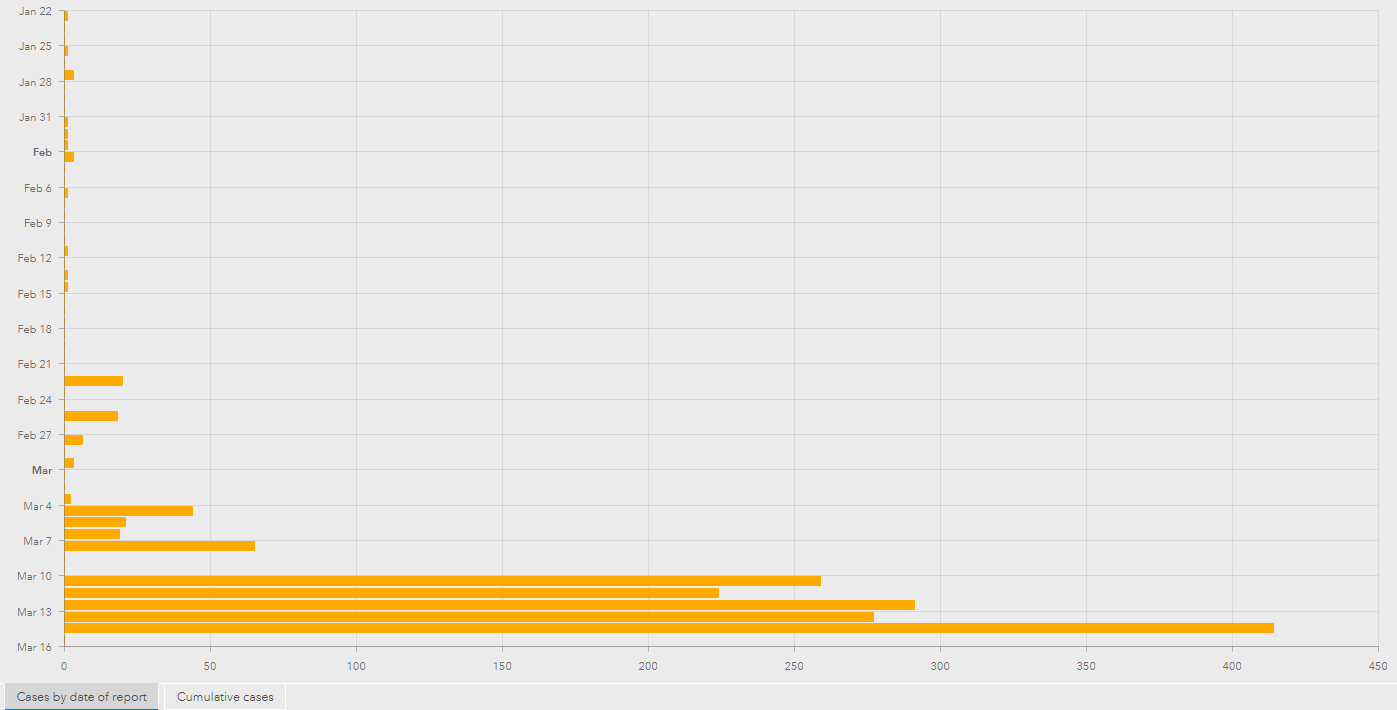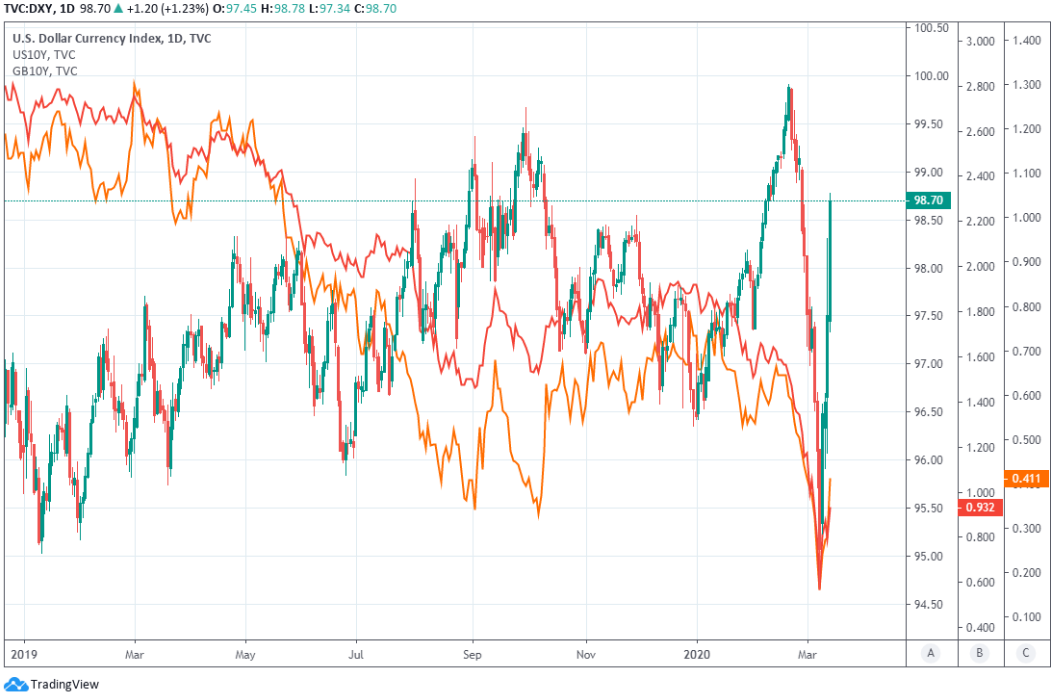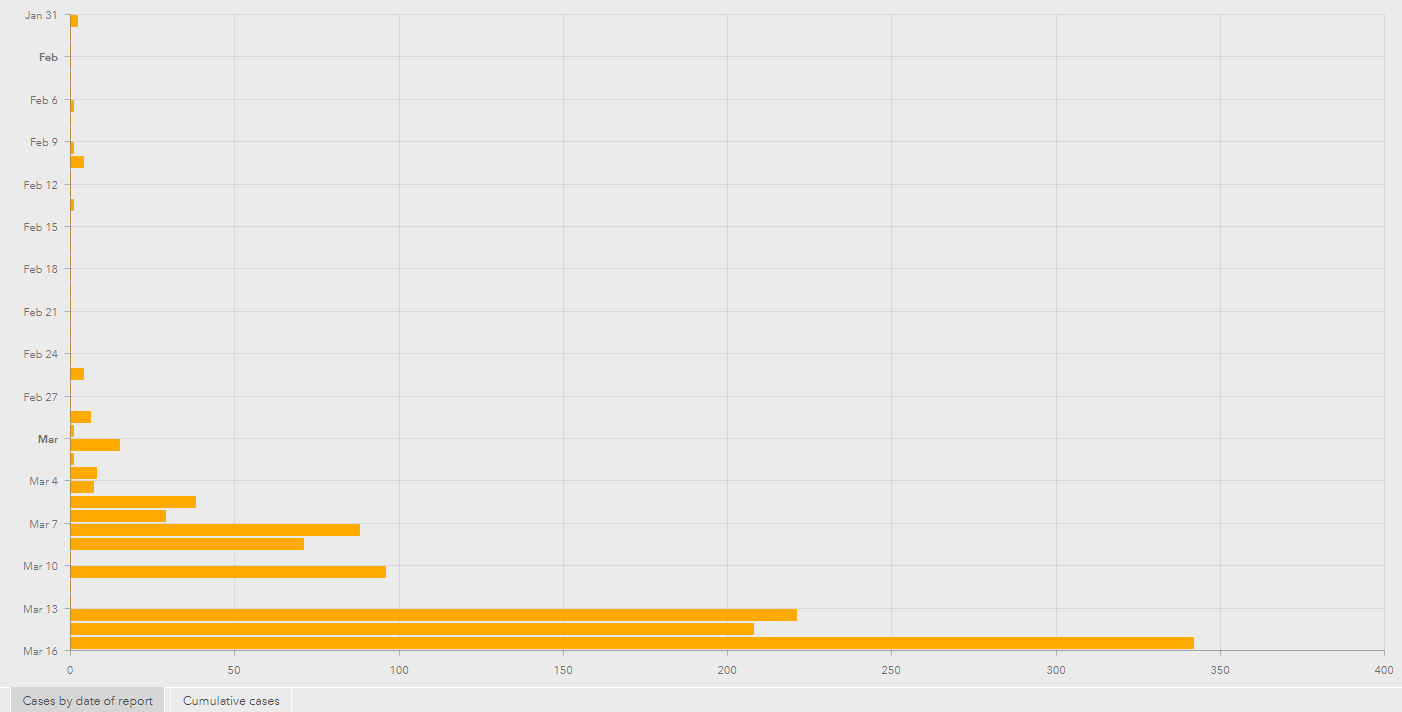Pound-to-Canadian Dollar Week Ahead: Finding Support on Charts as Loonie Reacts to Rate Cuts
- Written by: James Skinner
- GBP/CAD suffers its worst weekly loss since Oct 2016 flash crash.
- But finds support at familiar 1.70 level amid Sunday GBP rebound.
- Virus spread, policy response the important factor for FX ahead.
- UK on the verge of virus 'surge' that risks a bloody week for GBP.
- As CA waits on government stimulus package with PM in isolation.
- U.S. bans travel from the UK and FCO advises against travel to U.S.
- G7 to meet on coordinated fiscal and monetary response Monday.
- Fed has cut rates back to zero and restarted QE with $700bn program
- More central bank, government actions, volatility expected this week.
- More Brexit-referendum-sized moves are possible in weeks ahead.
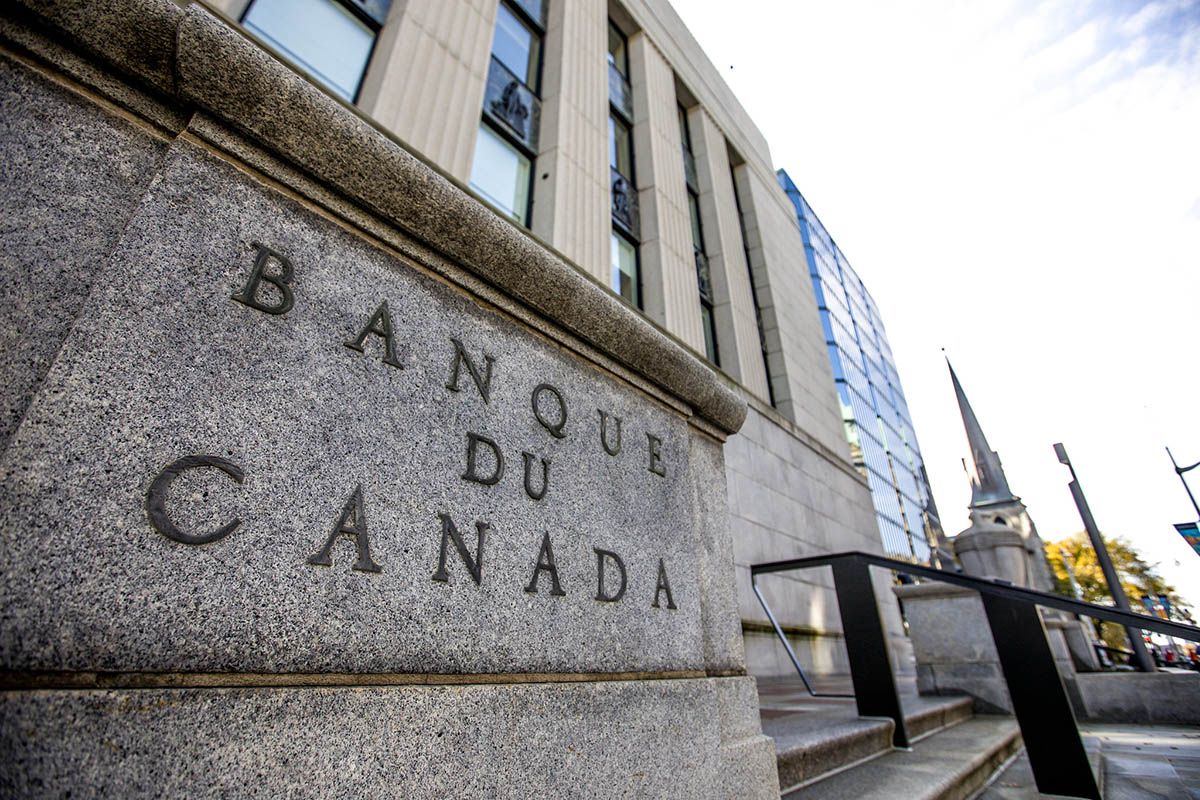
Image © Bank of Canada, Reproduced Under CC Licensing
- GBP/CAD Spot rate: 1.7060, -2.7% last week
- Indicative bank rates for transfers: 1.6450-1.6570
- Transfer specialist indicative rates: 1.6791-1.6894 >> Get your quote now
The Pound-to-Canadian Dollar rate closed its worst week since the October 2016 Sterling flash-crash Friday but it was finding support on the charts Sunday and could go on to recover somewhat over the coming days.
Sterling's Friday losses took it back to the 50% Fibonacci retracement of the August 2019 uptrend, from which it was bouncing on Sunday evening amid the Asia open, and it could now go on to recover at least in the short-term as investors respond to a yield crushing Bank of Canada (BoC) rate cut and developments from an eventful weekend that could have yet more adverse consequences for already beleaguered oil prices although there's no guarantee that any such reaction will be sustained.
Spain and France have joined Italy in 'locking down' citizens, forbidding all but essential travel from home and risking unprecedented damage to their economies that will likely necessitate a combined government and central bank response like no other seen in modern history. This was after the U.S. declared a national emergency. It comes that will see investors take their cues from epidemic curves in the major economies and the policymaker response.
The Pound continued its descent following Friday's rate cut from the BoC and USD/CAD fell further back from recent highs in what was a curious reaction given that currencies have a severe aversion to rate cuts and the BoC's has just wiped out what was once a handsome yield advantage for the Loonie.
Sterling has repeatedly found support around the 1.70 level on the charts in recent months and was bouncing from it again at the Sunday open amid a strong rebound in the Pound-to-Dollar rate and stability in the USD/CAD rate.
“There are only two factors now that will shape investor sentiment and financial market conditions – COVID-19 data and global policymakers’ response to the crisis. The news on the former is still not particularly good, but action from the Fed yesterday offers hope on the latter,” says Derek Halpenny, head of research, global markets EMEA and international securities at MUFG.
Above: Pound-to-Canadian Dollar rate shown at daily intervals. Finds support around 50% retracement of August 2019 trend.
The Federal Reserve (Fed) cut the Fed Funds rate range back to between 0% and 0.25% in another rare and unscheduled announcement on Sunday, reducing it from between 1% and 1.25%. The bank also said it will buy at least $500bn of government bonds and at least $200 billion of mortgage-backed securities, marking an official relaunch of its quantitative easing program. It didn't give a monthly purchase rate if there is ever any such thing, and last week's events are anything to go by that might be around $60bn.
That move came ahead of a Monday meeting between G7 finance ministers and central bank chiefs which investors hope will produce a policy repsonse that is coordinated between both, as well as between countries. That's necessary because with individuals increasingly confined to their homes in some places, companies and households face disruption to business and incomes, with potentially cataclysmic effects on national and global economies.
“We forecast considerable upside to USD/CAD. Outside of its normal meeting schedule, the Bank of Canada cut its policy interest rate by 50bp to 0.75% on 14 March. We now expect the Bank of Canada to cut its policy interest rate by 50bp to 0.25% at its next scheduled meeting on 16 April," says Joseph Capurso, a strategist at Commonwealth Bank of Australia.
Canada's Dollar, underwritten in part by a large oil trade with the U.S., has been sold heavily as the viral pneumonia works its way across the globe. Oil prices are down more than 50% for 2020 and with the Loonie's once-alluring yield appeal now completely shot away by the BoC's rate cut to 0.75%, the currency could face further declines in the week ahead as investors respond not only to the rate cut but also to the prospect of further declines in oil prices.
The Canadian Dollar is widely tipped to suffer more losses against the U.S. greenback but so too is the Pound, and quite how this plays out in GBP/CAD over the balance of the week remains to be seen. The relative pace of decline in the two currencies against the greenback will be key to where the Pound-to-Canadian Dollar rate ends up because exchange rate is in its simplest terms, the sum of GBP/USD over CAD/USD.
“The slump in oil prices will likely have a highly negative effect on the Canadian economy, which will already have to deal with the headwinds of the Covid-19 outbreak. The self-quarantined Prime Minister Justin Trudeau will unveil the fiscal response plan soon, despite the parliament now being shut due to the virus,” says Francesco Pesole, a strategist at ING. “We expect USD/CAD to keep moving towards the 1.45 area in the coming weeks.” 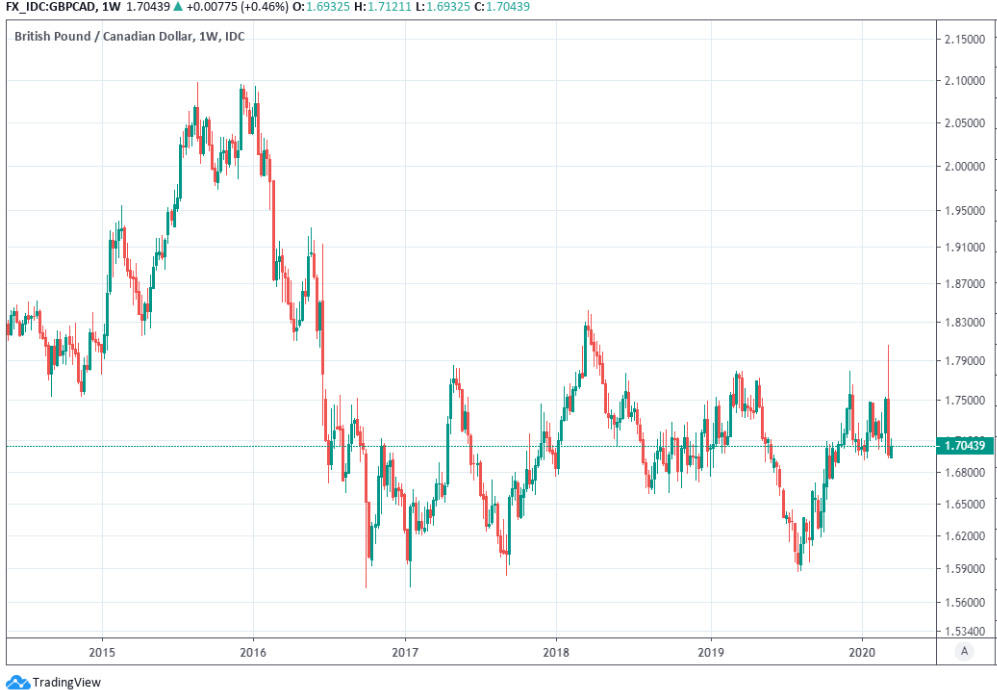
Above: Pound-to-Canadian Dollar rate shown at weekly intervals.
AA
What to Watch in the Week Ahead
There is a range of economic figures due from the UK and Canada in the week ahead, which would normally be important drivers of exchange rates but these all matter very, very little in the current market where the infection growth rates, death rates and the actions of authorities will are the only things that matter.
Economic data will become relevant again in the months ahead but this week's figures relate primarily to the economy of January and February, which is moot at a time when authorities are facing a de facto choice between allowing their economies or their health systems to collapse. Steepening epidemic curves (increasing infection growth rates) risk overloading healthcare systems given that 10% of patients suffering from the virus require intensive hospital care.
“We have seen a very high number of ICU admissions, almost entirely due to severe hypoxic respiratory failure requiring mechanical ventilation. The surge can be important during an outbreak and cluster containment has to be in place to slow down virus transmission. We are seeing a high percentage of positive cases being admitted to our Intensive Care Units, in the range of 10% of all positive patients,” says Prof. Jozef Kesecioglu, president of the European Society for Intensive Care Medicine, in an email to colleagues dated March 04. “We wish to convey a strong message: Get ready!”
For now the market focus is on trends in epidemic curves and actions to stem the spread as well as provide support for economies. The BoC took the lead last week with its second surprise rate cut, which came with Prime Minister Justin Trudeau in self-isolation after his wife tested positive for the virus.
The Canadian government is expected to unveil a substantial fiscal stimulus support package this week, which may help to stabilise the currency over the coming days. That support package would be a downside risk to the Pound-to-Canadian Dollar rate.
"The fall in oil prices, in conjunction with continued declines in equity prices as well as the impact of virus-related fears, should lead to back-to -back declines in economic activity in Canada unless a timely fiscal package is deployed in the country. We think a recession will be avoided in Canada as we assume the Federal government deploys fiscal stimulus to counter the negative effect of recent developments. A package of about 1% of GDP should lift growth above zero in Q3 and provide a modest buffer to downside risks,” saus Jean-Francois Perrault, chief economist at Scotiabank.
Above: UK epidemic curve. Source: World Health Organization.
France and Spain joined Italy in locking down citizens this weekend while New Zealand and Australia, which have among the least cases of major economies, announced that visiting travellers will need to self-isolate for 14 days.
Tourism, an important source of growth, had already collapsed everywhere in recent weeks but these moves could ensure the antipodean countries remain effectively closed to many holiday makers for the foreseeable future.
Above: Canadian daily disclousures of new infections. Source: World Health Organization.
This is the backdrop against which Monday's G7 meetings of central bank heads and finance ministers will take place and outcome of them will be key for investor sentiment and the mood in markets this week. The disease has spread to most of the world's countries in at least some capacity and is now threatening a sudden stoppage of a large parts of the global economy.
All markets saw extreme volatility last week with Thursday's losses putting many stock indices on course for their worst week in history before Fed actions and a significant announcement from President Donald Trump saw them more-than reversing earlier losses. However, and throughout all of this, Pound Sterling got almost no respite whatsoever. Sterling fell steeply against seven of nine major rivals including the Loonie last week.
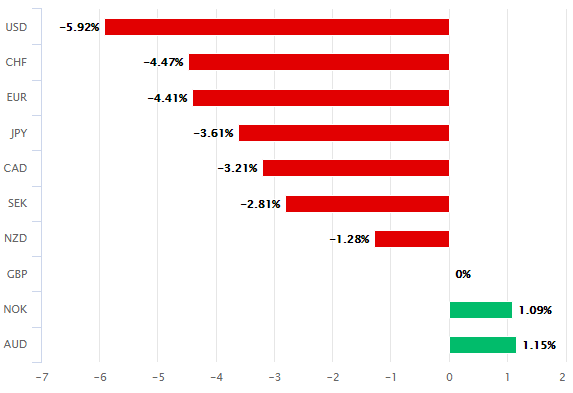
Above: Pound Sterling performance against major rivals last week. Source: Pound Sterling Live.
The Bank of Canada (BoC) announced its second surprise interest rate cut after the European close Friday and just before President Donald Trump declared a state of emergency, "unleashing the full force of the federal government" and unlocking around $50 bn in disaster relief funds. Congress has since reached a bipartisan agreement on measures to provide further support to U.S. companies and households as they grapple with the virus.
"The reported number of U.S. cases continues to rise sharply, and further dramatic-looking increases are inevitable as testing is ramped up, and the virus continues to spread Given that testing is not universal and most people with the virus don't need medical attention, the only way we'll know for sure that the outbreak is over is when the number of deaths begins clearly to fall. The number of deaths is still rising rapidly," says Ian Shepherdson, chief economist at Pantheon Macroeconomics.
Above: U.S. daily disclosures of new infections. Source: World Health Organization.
The Pound is at particular risk from a steepening epidemic curve for reasons including its earlier fortune in dodging a severe outbreak, which is now unwinding and could see Sterling becoming the "pariah" of the market. The Dollar, on the other hand, is the world's reserve currency and its largest, most liquid unit. That often makes it the go-to destination in times of risk-aversion.
Pound Sterling underwrites activity in the City of London, where assets under management are more than three times national GDP in the good times, and so could be vulnerable to capital flight in the event the UK suffers a sudden surge in coronavirus infections and deaths that threatens the smooth operation of London. It's also at heightened risk because of the government's strategy. The UK also has a large current account deficit, which means Sterling relies for part of its value on continuous inflows of foreign capital that risk being interrupted.
Above: Dollar Index shown at daily intervals alongside GB and U.S. 10-year Gov yields, which rise as bonds are sold.
"As countries with large outbreaks of Covid-19 move to testing only people sick enough to be in hospital, their data—and hence aggregate regional and global data—cease to be reliable. We don't know how many people have the disease, and we don't know how rapidly it's spreading," Shepherdson says. "It does seem, though, from data earlier in the outbreak, that cases in large outbreaks double every three our four days. That means, in theory, that an outbreak of 1,000 cases becomes more than a million cases after just 33-to-44 days."
The UK government moved from the "contain" phase of its strategy to the "delay" phase last week but there's very little difference in the actions and advice of government under the two purportedly different phases. Furthermore, and although a minister has denied the government's strategy is to pursue so-called 'herd immunity', its advisers have increasingly made use of the term.
Above: UK daily disclosures of new infections. Source: World Health Organization.
'Herd immunity' could arguably be described as a 'don't bother' strategy in which the coronavirus infection is left to work its way through society, claiming whoever it does in the absence of actions to protect the nations oldest and most vulnerable citizens. The Scientific Advisory Group for Emergencies (SAGE) said Saturday "the next planned effective interventions (shielding the vulnerable and household isolation) will need to be instituted soon."
"We have a plan, based on the expertise of world-leading scientists. Herd immunity is not a part of it. That is a scientific concept, not a goal or a strategy. Our goal is to protect life from this virus, our strategy is to protect the most vulnerable and protect the NHS through contain, delay, research and mitigate." says Health Secretary Matt Hancock in a Sunday article for The Telegraph, which is available without paywall on the gov.uk website.

